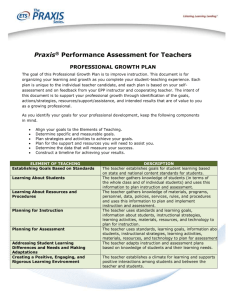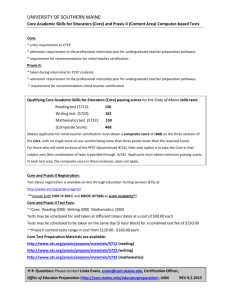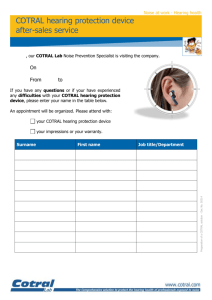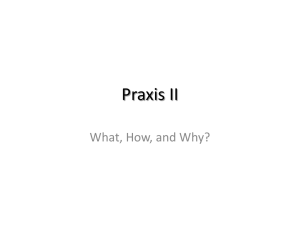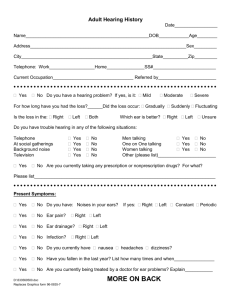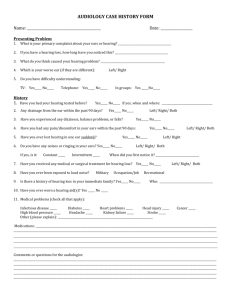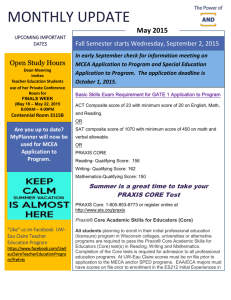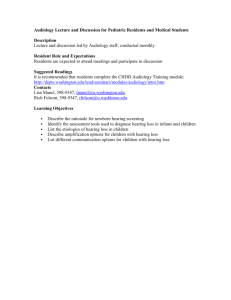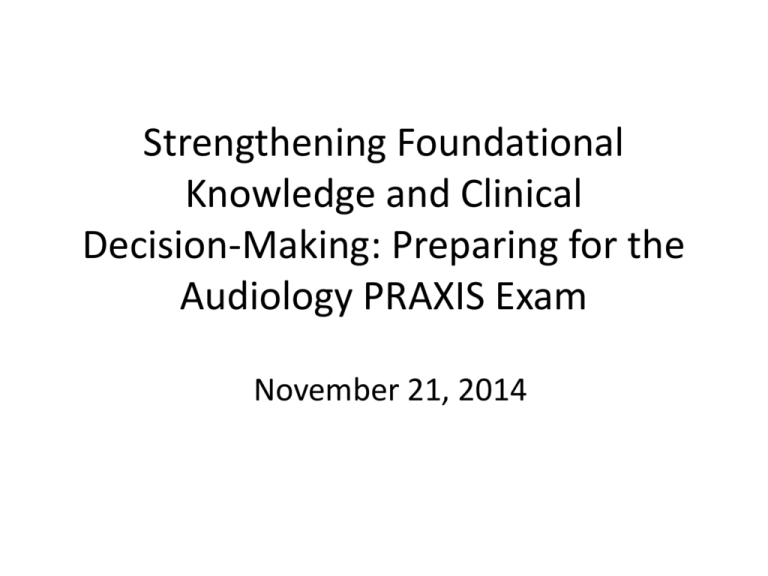
Strengthening Foundational
Knowledge and Clinical
Decision-Making: Preparing for the
Audiology PRAXIS Exam
November 21, 2014
Overview
• Praxis Overview – Kathy Pruner
• Test at a Glance – Lisa Lucks Mendel
• Foundations, Prevention & Identification, and
Professional Issues – Janet Koehnke
• Vestibular Case Study – Julie Honaker
• Pediatric Questions – Diane Sabo
• Adult Hearing Aids – Glenn Waguespack
• Wrap-up and Questions – Lisa Lucks Mendel
Background on ETS
• Non-profit organization, founded in 1947; combined ACE,
Carnegie Foundation and College Entrance Examination Board
• Mission: advance quality and equity in education for all people
worldwide
• ETS develops, administers, and scores
– 50+ million assessments in
– 180 countries at over
– 9,000 locations worldwide
Copyright© 2014 by Educational Testing Service. All rights reserved. ETS, the
ETS logo, LISTENING. LEARNING. LEADING., PRAXIS and THE PRAXIS
SERIES are registered trademarks of Educational Testing Service (ETS).
27141
3
How are ASHA’s Praxis Exams Developed?
[1]
Practice
Analysis
[7]
Passing
Score
Determined
[6]
Standard
Setting
[2]
Test
Blueprint
Test
Development/
Regeneration
Process
[5]
Validity
[4]
Equating
Set
[3]
Item
Writing
2014-2015 Testing Schedule
Remaining Audiology Testing Windows:
•
•
•
•
•
12/8/14 – 12/20/14
2/9/15 – 2/21/15
3/9/15 – 3/21/15
4/6/15 – 4/18/15
6/15/15 – 6/26/15
With computer tests, you can register up to 3 days
before test day and not pay a late fee.
Copyright© 2011 Educational Testing Service. All rights reserved. ETS, the ETS logo and LISENTING. LEARNING. LEADING.
are registered trademarks of Educational Testing Service (ETS). THE PRAXIS SERIES is a trademark of ETS.
Test Prep Materials for
The Praxis® Audiology Exam
Copyright © 2011 by Educational Testing Service. All rights reserved. ETS, the ETS logo and LISTENING. LEARNING. LEADING., PRAXIS I, PRAXIS II and SCORELINK are
registered trademarks of Educational Testing Service (ETS). PRAXIS and THE PRAXIS SERIES are trademarks of ETS. 17025
Free Test Prep
• Comprehensive Praxis Study Companion
– Test at a Glance (TAAG)
– Reducing Test Anxiety
– Study Plan document
• Prerecorded Webinars: on demand webinar videos
– Assists those who are not able to attend live
webinars due to class, work, or time zone conflicts
• Live 1-hour webinars: all start at 1:00 P.M. ET
– Tuesday, January 27, 2015
7
Study Companion Contains Sample Test
Questions and Rationales
Answer with Rationale Provided
Copyright© 2014 Educational Testing Service. All rights reserved. ETS, the ETS logo, LISENTING. LEARNING. LEADING.,
THE PRAXIS SERIES and Praxis are registered trademarks of Educational Testing Service (ETS).
Sample Study Plan Using Study
Companion
Content
covered
Description
of content
How well do I
know the
What resources Where can I find
content?
do I have/need the resources I
(scale 1–5) for this content?
need?
Content based
on TAAG
Dates I will
study this
content
Test taker fills in grid
to develop study plan
Copyright© 2011 Educational Testing Service. All rights reserved. ETS, the ETS logo and LISENTING.
LEARNING. LEADING.
are registered trademarks of Educational Testing Service (ETS). THE PRAXIS SERIES is a trademark of
Date
completed
“Strategies for Success” Video
www.ets.org/praxis/strategiesforsuccess
11
“What to Expect on Testing Day” Video
www.ets.org/praxis/testday
12
Updated Computerized Testing Experience Video
www.ets.org/praxis/computertestingdemo
13
Interactive Practice Tests
• Detailed explanations for correct answers to the
practice questions
• Content category scores indicating the number of
questions answered correctly in each content
category to help candidates understand their
performance level
• Real test directions and questions similar to those
you will see on test day
• A timer that to simulate the actual test experience
• $17.95 for 10 uses or 90 days
• SLP and Audiology IPTs will be available Jan. 2015
14
Interactive Practice Test
15
Test Prep Discount Offer
Save 10% on Praxis Test Preparation
1. Visit www.ets.org/praxis/store
2. Enter Promo Code: CRDKP for each
resource you order
Note: promo code is not case sensitive
Praxis Score Reports:
Reviewing Your Performance
Your Score
• Score scale is 100-200 in 1-point intervals
• Unofficial score results viewed immediately
at test center
• Official score reports available online 10-12
business days after the window closes
• Scores are available online for 1 year for you
to download
• Additional score reports: $40
18
Sample Score Report
Category Performance
Recent Enhancements
• You now get 4 free score reports instead of 3—a
savings of $40
– Note that many state education departments
automatically receive your scores if you test in that state.
• Registration is simplified – you now choose
agency/ASHA (or state) for listing of required test
(rather than searching by test name or from the
entire list) – cutting down wrong choices
• You will receive e-mail notification when scores are
ready
• Access from your Praxis account and print copy for
your records
21
Test Taker Support
General Inquiries:
Phone: 800-772-9476 (U.S., U.S. Territories,
and Canada) or at 609-771-7395 (for all
other locations)
E-mail: praxis@ets.org
Hours: Mon-Fri, 8:00 A.M. – 7:45 P.M. ET
Copyright© 2014 Educational Testing Service. All rights reserved. ETS, the ETS logo and LISENTING. LEARNING. LEADING. and Praxis
are registered trademarks of Educational Testing Service (ETS). THE PRAXIS SERIES is a trademark of ETS.
Audiology
Test at a Glance
Lisa Lucks Mendel
University of Memphis
Test at a Glance (TAAG)
Provides test blueprint to help develop a study plan
Highlights the topics
covered and in what
proportion
Foundations (10%)
• Acoustics/psychoacoustics
• Anatomy, physiology and behavior over the life
span
• Etiology
• Pharmacology, ototoxicity, and vestibulotoxicity
• Psychometrics and instrumentation
• Principles of counseling
• Cultural and linguistic diversity
• Deaf culture
Prevention and Identification (10%)
• Education and Prevention (Conservation)
– Causes and effects of hearing loss and vestibular
disorders
– Protection from hearing loss and vestibular
disorders
– Universal precautions
– Selection and fitting hearing protection devices
Prevention and Identification (cont.)
• Screening and Risk Assessment
– Selecting and administering procedures to identify
those who need
•
•
•
•
Further diagnosis and/or treatment
Referral for speech and/or language assessment
Referral for other professional services
Vestibular evaluation and/or treatment
– Universal newborn hearing screening
– Self-report measures
Assessment (40%)
• Assessment Planning
– Case history
– Equipment function
– Selecting and modifying procedures as necessary
• Audiologic Evaluation
– Administering and interpreting the behavioral test battery
(pure tone audiometry, speech audiometry,
pseudohypacusis)
– Administering and interpreting the physiologic test battery
(immittance, OAEs, AEPs)
– Administering and interpreting other assessments
(otoscopy, balance system assessment, communication
function, tinnitus, APD)
Assessment (cont.)
• Integrating assessment results (behavioral,
physiologic, neurodiagnostic, balance
function)
• Documentation and communication of
procedures and results of evaluations
– Generating recommendations
– Communicating results
– Interacting with clients, families, and professionals
Intervention (30%)
• Treatment Planning
– Evaluating client information to facilitate treatment
planning
– Selecting and modifying treatment procedures based
on client factors
– Integrating results of assessments to support
treatment recommendations
• Device Selection
– Evaluating client’s perceived handicap
– Determining candidacy for hearing aids, cochlear
implants, hearing assistance technology, etc.
Intervention (cont.)
• Hearing Aids
– Evaluating, programming, coupling
– Selecting features
• Cochlear Implants
– Programming, evaluating effectiveness,
selecting strategies
• Device Verification and Validation
– Verifying proper function of hearing aids,
assistive devices, and cochlear implants
– Conducting electroacoustic analysis
– Probe microphone verification (RECD, REIG,
REAR)
– Repairing and modifying hearing technology
Intervention (cont.)
• Audiologic Rehabilitation
– Planning and evaluating
– Communication strategies
– Tinnitus management
– Vestibular rehabilitation
– Counseling
• Documentation and Communication
Professional Issues (10%)
• Professional Practice
– Service delivery models
– Management and business practices
– Equipment, calibration, and maintenance
• Legal and ethical practice and advocacy
– Professional conduct
– Patient rights
– Legislative and regulatory mandates
• Evidence-Based Practice
– Application of research findings
– Research principles and practices
TAAG
• Sample Test Questions
• Answers with rationales
Foundations Questions: Some
Examples
Janet Koehnke
Praxis Committee member
What to Expect
• In the new test form 10% of the questions are
in this category
• Subcategories include:
– Acoustics/Psychoacoustics
– Anatomy/Physiology & Behavior over the lifespan
– Etiology
– Pharmacology, Ototoxicity, Vestibulotoxicity
– Psychometrics & Instrumentation
– Principles of Counseling
– Cultural & Linguistic Diversity
Individuals with normal hearing sensitivity in one ear
and a severe hearing loss in the other ear experience
the following:
A gain in speech understanding when the noise is closer to the
ear with hearing loss
Improved ability to localize when the noise source is closer to the
ear with normal hearing
Better speech understanding and localization as the reverberation
time increases
More difficulty understanding speech when the speaker moves
closer to the ear with hearing loss
Improved localization when the noise is at 00 azimuth and the
source is closer to the ear with hearing loss
ANSWER: #1
WHY? When the more favorably placed ear (i.e., the better ear) is further from
the noise source the SNR improves in the better ear
It is well known that for individuals with unilateral hearing loss, speech
intelligibility improves in this situation
Diagnostic audiometers generally provide onethird-octave noise for use in masking pure tones.
This bandwidth is used because bands of that
width:
Are centered at the frequency range of normal
speech
Encompass the width of a critical band
Produce more masking than pink noise does
Produce more masking than half-octave bands do
Are less than the width of a critical band
ANSWER: #2
WHY? Narrow bands of masking noise should be wider than a critical band
so that they will provide effective masking at the test frequency without
requiring overall levels that are higher than necessary.
A patient tells an audiologist that she recently received
surgery for otosclerosis in her right ear. The ENT indicated
that the procedure was successful. However, the surgeon
nicked the chorda tympani. Which of the following is the
patient likely to report?
Decreased hearing in the low frequencies
Difficulty swallowing
Decreased sensation of taste
Decreased hearing in the high frequencies
Numbness on one side of her face
Answer: #3
WHY? The chorda tympani, which is a branch of the facial nerve (VII) is
responsible for the sensation of taste in the anterior two-thirds of the
tongue. When it is damaged or nicked, taste is affected.
An audiometer attenuator is set to 0 dB HL. Which
of the following is true about the sound pressure
level output of the earphone?
It is constant across all frequencies
It is lowest at midfrequencies
It increases as a function of frequency
It is highest at 4000 Hz
It decreases 6 dB per octave
Answer: #2
WHY? The SPL necessary to achieve 0 dB HL is highest at low
frequencies, decreases in the mid-frequencies, and increases again
at high frequencies.
ASSESSMENT AND INTERVENTION
VESTIBULAR PORTION
Julie A. Honaker, Ph.D.
Audiology NAC Member
Vestibular Question 1
A patient is seen for vestibular evaluation with the primary complaint of
persistent imbalance for past 6 months. She states that she had one severe
attack of true rotary vertigo 6 months ago, and since then fears another will
occur. Quick movements increase her symptoms. She reportedly takes
meclizine daily.
VNG results indicate normal ocular-motor function. A second-degree leftbeating nystagmus is observed during gaze testing without fixation.
Postactive head-shake nystagmus reveals a left-beating nystagmus. No
positional or positioning nystagmus is observed. Bilateral bithermal caloric
results indicate a 50% weakness with no directional preponderance.
a)
b)
c)
d)
e)
Based on the above information the patient most likely has…
Meniere’s Disease
A central vestibular pathology
A statically uncompensated peripheral pathology affecting the right ear
A dynamically uncompensated peripheral pathology affecting the left ear
A dynamically uncompensated peripheral pathology affecting the right ear
Let’s break this down
Vestibular Question 1
A patient is seen for vestibular evaluation with the primary complaint of
persistent imbalance for past 6 months. She states that she had one severe
attack of true rotary vertigo 6 months ago, and since then fears another will
occur. Quick movements increase her symptoms. She reportedly takes
meclizine daily.
VNG results indicate normal ocular-motor function. A second-degree leftbeating nystagmus is observed during gaze testing without fixation.
Postactive head-shake nystagmus reveals a left-beating nystagmus. No
positional or positioning nystagmus is observed. Bilateral bithermal caloric
results indicate a 50% weakness with no directional preponderance.
Answer: E Based on the above information the patient most likely has…
a) Meniere’s
Disease
Rationale:
VNG
results normally provide site-of-lesion specific
b) A central (i.e.,
vestibular
pathology
information
caloric
irrigations) to determine probable side of
c) A statically
uncompensated
pathology
the right
ear
weakness.
In this
example, peripheral
the patient
had aaffecting
50 percent
right
d) A dynamically uncompensated peripheral pathology affecting the left ear
peripheral
vestibular weakness, suggesting a peripheral pathology
e) A dynamically uncompensated peripheral pathology affecting the right ear
affecting the right side. The postactive head-shake left-beating
nystagmus suggests that the lesion is dynamically uncompensated.
Vestibular Question 2
Which of the following always applies to
nystagmus caused by a labyrinthine lesion?
a) It’s right-beating on right gaze & left-beating
on left gaze.
b) It is pendular when the eyes are closed
c) It is enhanced when the eyes are open
d) It is up-beating on up gaze and down-beating
on down gaze
e) It is suppressed by visual fixation
Let’s break this down
Vestibular Question 2
Which of the following always applies to
nystagmus caused by a labyrinthine lesion?
a)
b)
c)
d)
e)
It’s right-beating on right gaze & left-beating on left gaze.
It is pendular when the eyes are closed
It is enhanced when the eyes are open
It is up-beating on up gaze and down-beating on down gaze
It is suppressed by visual fixation
Answer: E
Rationale: Visual suppression always suppresses nystagmus caused by a
peripheral lesion, such as a labyrinthine lesion.
Vestibular Question 3
A 52-year-old patient is seen in your clinic for complaints of a vestibular crisis
event lasting for 3 days with continuous symptoms of vertigo and nausea. He
notes that his continuous symptoms improved, but he now reports head motion
provoked symptoms of vertigo, in particular when he moves his head in the
sagittal plane. He was evaluated in your clinic with VNG assessment and testing
showed normal oculomotor function, right-beating spontaneous nystagmus,
absent cool, warm and ice water caloric responses on the left, and left posterior
canal benign paroxysmal positional vertigo (BPPV).
a)
b)
c)
d)
e)
Which of the following general statement best applies to this patient…
The findings suggest complete loss of function of the left vestibular system.
The findings suggest complete loss of function of the left horizontal canal with
preserved function in the anterior canal.
The findings suggest loss of left horizontal canal function, at least in the lower
frequency range, with preserved posterior canal function.
The findings suggest incomplete bilateral vestibular system loss.
The findings suggest complete loss of left posterior canal function, with preserved
horizontal and anterior canal function.
Let’s break this down
Vestibular Question 3
A 52-year-old patient is seen in your clinic for complaints of a vestibular crisis
event lasting for 3 days with continuous symptoms of vertigo and nausea. He
notes that his continuous symptoms improved, but he now reports head motion
provoked symptoms of vertigo, in particular when he moves his head in the
sagittal plane. He was evaluated in your clinic with VNG assessment and testing
showed normal oculomotor function, right-beating spontaneous nystagmus,
absent cool, warm and ice water caloric responses on the left, and left posterior
canal benign paroxysmal positional vertigo (BPPV).
Which of the following general statement best applies to this patient…
Answer:
C
a) The findings suggest complete loss of function of the left vestibular system.
VNG
caloric
test loss
results
provide
site-of-lesion
b)Rationale:
The findings
suggest
complete
of function
of the
left horizontal canal with
preserved function
in the anterior
information
suggesting
loss of canal.
left horizontal canal function at least
c) The findings suggest loss of left horizontal canal function, at least in the lower
in the
low frequency
range (frequency
range
of caloric irrigations).
frequency
range, with preserved
posterior canal
function.
d)TheThe
findings suggest
incomplete bilateral
vestibularalso
system
loss. the findings
right-beating
spontaneous
nystagmus
support
e)of left
The vestibular
findings suggest
complete
lossleft
of left
posterior canal
canal function,
with preserved
paresis.
The
posterior
BPPV
suggests
that
horizontal and anterior canal function.
the left posterior canal is functioning.
Back Page
Pediatrics
Audiology PRAXIS
NSSLHA Day at ASHA—2014
Pediatrics
Question 1
• A newborn did not pass their newborn
hearing screen and is seen for diagnostic
follow up testing. Of the following tests, which
would be the least beneficial for providing
diagnostic information about hearing loss?
a.
b.
c.
d.
Distortion product otoacoutic emissions
Behavioral observation audiometry
Acoustic immittance measures
Auditory brainstem response testing
Pediatrics
Answer 1
• The answer is B, behavioral observation
audiometry (BOA). While it is important to
understanding the child’s responses to sound,
BOA is not a test that provides threshold
information or aids in differential diagnosis.
• Otoacoustic emissions and acoustic
immittance measure, while not assessing
threshold, do aid in the differential diagnosis
of hearing loss.
Pediatrics
Question 2
• When conducting an audiological evaluation, it is
important to take into consideration the infant’s
gestational age, rather than chronologic age when
interpreting the results. If an infant is born at 32
weeks gestation which of the following tests is most
impacted by this gestational age.
A. DPOAE amplitude
B. ABR Wave V
C. ABR threshold
D. TEOAE frequency response
Pediatrics
Answer 2
• Answer B is correct as prematurity impacts
the physiology of myelinization of the auditory
nervous system, in turn, affecting the latencies
of auditory evoked potentials up to about 18
months of age.
• The other tests are not affected unless hearing
loss is present or the child is being testing
younger than 32 weeks gestation.
ASSESSMENT/INTERVENTION
QUESTIONS: RELATED TO
DISPENSING/FITTING
Glenn Waguespack, Audiology NAC Member
1. A patient who has had a sudden profound sensorineural hearing loss in
the left ear has undergone a complete otological evaluation, including a
prescribed course of steroids, an MRI, and serial audiograms. The
otologist has determined that the loss is irreversible and is referred to you
for follow-up. The most logical next step is…
A. Fitting with a power behind-the-ear hearing aid
on a trial basis
B. Enrollment in speechreading classes
C. Trial with an osseo-integrated cochlear device
D. Referral to another otologist for a second opinion
E. Referral to a speech-language pathologist for
information regarding speech conservation
Answer is C – Rationale - Osseo-integrated devices (formerly
called BAHA) have as one of their promotional uses an
appropriate fitting for single-sided deafness.
2. A patient has been identified with normal hearing bilaterally through
1500 Hz with a sharply sloping sensorineural loss in the frequency range
above 1500 Hz. The most appropriate system of amplification is :
A. Binaural completely in-the-canal hearing aids
B. RITE aids with an open ear fitting
C. Binaural behind-the-ear hearing aids with
occluding earmolds
D. In-the-ear aids with no venting
E. An assistive listening device (e.g. Pocket Talker)
Answer is B – Rationale - RITE aids with an open fitting are least
likely to cause problems with the occlusion effect and are
programmable to provide amplification in the appropriate
frequency range(s). CIC or canal aids generally cause problems
with occlusion in patients with normal low and mid-frequency
hearing.
3. A practicing attorney with a progressive bilateral sensorineural hearing
loss has worn power BTE aids for many years. The loss has progressed to
the point where his word recognition scores are less than 50%, and his
communication problems have gotten significantly worse. The most
appropriate recommendation for this patient is…
A. Trial period with a body type hearing aid and earmolds
coupled to a Y-cord
B. Hearing aids utilizing frequency transposition technology
C. Use of an FM system in difficult listening environments
D. A cochlear implant
E. Training in speechreading
Answer is D – Rationale - A cochlear implant is the most
appropriate recommendation since its use would not be
restricted just to specific situations. Additionally, conventional
hearing aids are no longer functional for the patient
4. A new user of binaural behind-the-ear hearing aids returns to the
audiologist during the 30-day trial period with a complaint that sound is
reverberant and hollow and that her own voice sounds as if it were in a
barrel. Which of the following would be most helpful in this situation?
A.
B.
C.
D.
Lowering the OSPL 90
Adding a vent or enlarging the present vent
Ordering a new earmold without a helix
Adding a 687-ohom or 1500-ohm damper to
the earhook
E. Widening the end of the earmold bore
Answer is B – Rationale - Venting an earmold is recommended to
lessen the occlusion effect and reduce some of the low-frequency
gain that may be causing the barrel-sound when the patient speaks.
5. A 40-year old woman who has experienced a gradual onset of a left-sided
hearing loss since the age of 35 presents with a high frequency hearing loss
in the left ear and a reduced word recognition score in that ear. The most
appropriate recommendation is:
A.
B.
C.
D.
E.
Administer an auditory brainstem response rate study
An otological evaluation
Otoacoustic emission testing
Fitting of appropriate amplification
Re-evaluation in 3-6 months to check the stability of
the hearing levels
Answer is B – Rationale - The otological evaluation is recommended,
given the gradual onset of the loss and the reduced word recognition
score. An MRI ordered by the otologist would provide the most
diagnostic information and treatment recommendations.
6. A 50-year old patient presents with a history of having worked in a
factory without ear protection for a number of years. Which of the
following is NOT likely to be characteristic of his hearing loss?
A. He may have more difficulty understanding women
and children
B. He may experience communication problems in a
noisy restaurant
C. He may complain of an occasional ringing in both ears
D. His audiogram is likely to show a unilateral hearing
loss
E. He may obtain benefit from appropriate hearing aids
Answer is D – Rationale - Unilateral hearing losses are not typical of
audiometric configurations for individuals who work in noisy
environments. Hearing generally shows a symmetrical hearing loss.
Session Wrap-Up
Lisa Lucks Mendel
University of Memphis
What you need to know about the
test…
• The exam is intended to be taken by AuD students in their
final year
• The level of the exam has changed
– Questions are now geared toward requisite knowledge
achieved at the doctoral level, as directed by the profession
• There are more clinical decision-making questions
(Analysis/Synthesis), rather than just at the
knowledge/comprehension level
• Only questions answered correctly count toward exam
score; guessing is encouraged
• Raw points awarded for number of correct answers; scaled
score computed from total number of raw points
• Some questions may not count toward your score
What you need to know about the test…
• Academic programs receive candidates’ score
reports
– Be sure to select ASHA and your attending institution
as recipients of your score
• Results submitted for initial certification for ASHA
must have been obtained no more than 5 years
prior to submission of application
– Audiology certification applicants who do not make a
passing score have 2 years from date of application to
retake and pass Praxis
• Test accommodations are available
Test-Taking Strategies
• Don’t leave any questions blank since your score is
based on the number of questions you answer
correctly with no penalty for an incorrect answer
• If you don’t know the answer, try to eliminate obvious wrong
answers and guess the correct one
• Pace yourself and allow ample time per question
• You can answer questions in any order
– You can mark harder questions for “Review” using a review
button and come back to them by viewing the review page
– Practice these features at
www.ets.org/praxis/computertestingdemo
• Read all possible answers before picking one
• Review your answers if you have time
• You just need a passing score
Smart Tips
• Don’t sell your textbooks from
• Scan the answer choices before
introductory classes as they can be
you start reading the material
an important source of study
and/or working the problem.
material.
• In multiple-choice items, you
• Don’t worry about your score when
need to choose the correct
taking the test.
answer, but you do not need to
• Keep track of time.
prove it. Don’t waste your time.
• Do not take too much time on any
trying to prove the answer.
one question.
• Be well rested on test day.
• Be aware of key words such as
NOT, BEST, LEAST, EXCEPT …
Copyright © 2012 Educational Testing Service. All rights reserved.
Are you ready?
• Know the test requirements for ASHA/licensure
board/state
• Know the topics to be covered on the test
• Review textbooks, class notes, and course readings
for these topics
• Know test time, number, and type of questions
• Familiarity with different M/C question types
• Know test taking strategies
• Worked through practice questions in the Study
Companion
Test Prep Resources
• Take advantage of the resources available to you
– Praxis website www.ets.org/praxis
– Bulletin: http://www.ets.org/s/praxis/pdf/praxis_information_bulletin.pdf
• Free Resources http://www.ets.org/praxis/prepare/materials/5342
–
–
–
–
Study Companion (5342) http://www.ets.org/s/praxis/pdf/5342.pdf
Computer-Delivered Testing Demonstration
Strategies for Success video
Test Prep Webinars
• Priced Resources
– Audiology Study Guide eBook ($22.95)
– Interactive Practice Test ($17.95) – available by January 2015
In Summary
• Know about the Audiology test
• Prepare a Study Plan to aid in a thorough review
of content
• Practice responding to sample questions from
the Study Companion
• Practice by taking the sample test in Audiology
Study Guide
• Practice time management strategies
• Practice anxiety-reducing techniques

